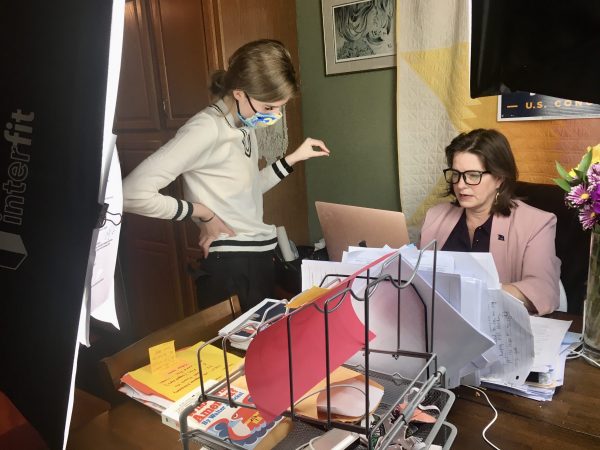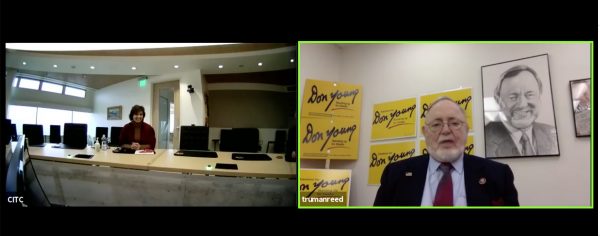
U.S. House candidate Alyse Galvin is running a $4 million campaign, and if you’ve turned on a television in Alaska or spent some time on the internet, you’ve seen where a lot of that money is going. Galvin has raked in more than double what Young has raised, and going into the last week before election day, she had substantially more cash on hand.
But in her Rogers Park split-level in Anchorage, the Galvin campaign operates on a much smaller scale. And it’s a family affair.
Galvin has professional advisors and campaign staffers but her daughter Bridget Galvin is her communications director, and this night Bridget is getting the candidate prepped for a series of Zoom sessions. It’s a typical evening in the Galvin household.
“Eagle River, Mat-Su, Anchorage for the first one,” Galvin said, to confirm it with Bridget. “OK.”
Galvin is attempting what so many before her have tried and failed: to unseat Congressman Don Young, who has bested all challengers since 1973.
Read more coverage of the 2020 elections in Alaska
Galvin herself tried two years ago and fell short. This time she has more money, and experience to draw on, but there’s also a pandemic to contend with.
At her home, the dining room has been turned into a Zoom studio. Specialty lights on tripods flank the table, to illuminate Galvin’s face. Her backdrop is a hand-made quilt hanging on the wall behind her. A new puppy chews a toy in the living room.
“Hello Alaska! Thank you for taking the time tonight,” Galvin tells the Zoom audience. “Elsa! I haven’t seen you in so long.”
Shaking hands and kissing babies — those are out this year. Here, in front of her laptop screen is where Galvin connects, virtually, with volunteers and people who just want to learn more about her. On this October night, she’s giving a series of pep talks for supporters who are about to make phone calls on her behalf.
Galvin told them that what they provide — as Alaskans talking to their friends and neighbors — is uniquely helpful to the campaign.
“Because they’ll trust you,” she said. “And if you say ‘I’ve met her. She’s real. She’s hard-working’ and all the details we know about Don Young … appreciate that he’s put in a lot of years, but lately, unfortunately, he doesn’t have the clout to deliver.”
That’s a principle claim in her ads — that Young has lost his clout. To smaller groups, Galvin spends more time emphasizing her attributes, like her willingness to listen. She gives out her phone number to the Zoom participants and invites them to relay the individual stories they hear in their regions. Galvin says she wants to hear about the needs of Alaskans who have health care challenges, or those who are newly unemployed.
“Those are the sorts of stories that I need to keep within me and carry, not only on the trail, but in Washington,” she said.
In addition to Zoom sessions, Galvin hosts phone conferences and “tele-town halls” to reach Alaskans who don’t have reliable broadband. She also holds drive-in rallies.
Election forecasters say Young has the advantage, but it’s not deemed a safe seat this time. That’s in part due to a flood of contributions from around the country that have poured into Democratic campaigns. (Or in Galvin’s case, to a non-partisan candidate who is the Democratic Party’s nominee.)
Slightly more than half of the money she’s received from individuals is from non-Alaskans, according to the Center for Responsive Politics. Non-residents contributed about 53% of the money Young has raised from individuals, and more than 40% of his total comes from Political Action Committees, not individuals.

Sabato’s Crystal Ball, a publication of the Center for Politics at the University of Virginia, has the race in the “leans Republican” column.
“I know how much better funded a lot of Democrats are across the country,” said Crystal Ball Associate Editor J. Miles Coleman. “But I think when you’re such a known quantity like Don Young, I think that really helps.”
After 47 years with the same congressman, voters know who Young is. Nationally, the pandemic seems to be a political liability for Republicans, but Coleman said it may hurt Galvin more than it hurts Young, particularly in rural Alaska. Young already has supporters there while the virus has kept Galvin at bay. And Coleman said the electorate might take in stride Young’s “beer virus” joke from March.
“Don Young had sort of sort of a gaffe earlier where he tried to downplay it,” Coleman said. “But I mean, he’s always said that type of off-the-cuff stuff. So to me, it’s like, ‘Okay, are the voters going to think ‘Yeah-no. That’s just him being him.’”
How Young is adapting his ground game to the pandemic isn’t entirely clear. His campaign did not make anyone available for an interview for this story despite several requests.
But he is participating in video-conference forums, and he did recently participate in a “telephone rally” aimed at Alaskans. It starred President Trump, and Young was effusive.
“Thank you for being the greatest president of all, and I say that because you’ve done so much for Alaska. I’m excited about it,” Young said on the call, which thousands of Alaskans are said to have listened to. “We’re a great team together with (Sen.) Dan Sullivan and yourself and myself.”
Like his challenger, Young is running lots of ads, even on buses in Anchorage, in which he pounds the message that Galvin is “too liberal” for Alaska.
Voters will decide if that’s true. They’re deciding already.
Liz Ruskin is the Washington, D.C., correspondent at Alaska Public Media. Reach her at lruskin@alaskapublic.org. Read more about Liz here.





